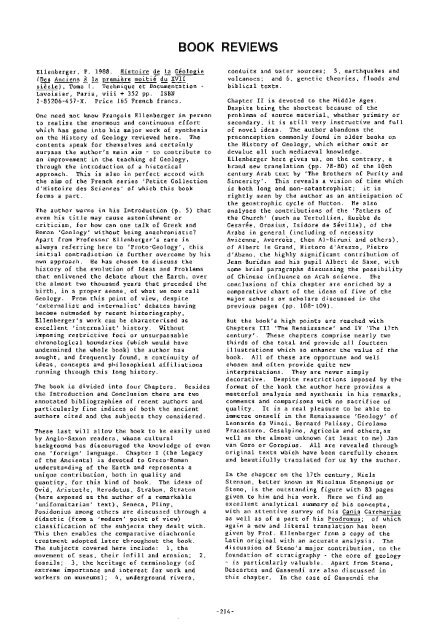Number 5 - Geological Curators Group
Number 5 - Geological Curators Group
Number 5 - Geological Curators Group
Create successful ePaper yourself
Turn your PDF publications into a flip-book with our unique Google optimized e-Paper software.
BOOK REVIEWSEllenberger, F. 1988. Histoire GBologie(Des Anciens 4 la premiere moiti6 du XVIIsihcle), Tome 1. Technique et Documentation -Lavaisier, Paris, viii + 352 pp. ISBN2-85206-457-X. Price 165 French francs.One need not know Frangois Ellenberger in personto realise the enormous and continuous effortwhich has gone into his major work of synthesison the History of Geology reviewed here. Thecontents speak for themselves and certainlysurpass the author's main aim - to contribute toan improvement in the teaching of Geology,through the introduction of a historicalapproach. This is also in perfect accord withthe aim of the French series 'Petite Collectiond'Histoire des Sciences' of which this bookforms a part.The author warns in his Introduction (p. 5) thateven his title may cause astonishment orcriticism, for how can one talk of Greek andRoman 'Geology' without being anachronistic?Apart from Professor Ellenberger's care inalways referring here to 'Proto-Geology', thisinitial contradiction is further overcome by hisown approach. He has chosen to discuss thehistory of the evolution of Ideas and Problemsthat enlivened the debate about the Earth, overthe almost two thousand years that preceded thebirth, in a proper sense, of what we now callGeology. From this point of view, despite'externalist and internalist' debates havingbecome outmoded by recent historiography,Ellenberger's work can be characterised asexcellent 'internalist' history. Withoutimposing restrictive foci or unsurpassablechronological boundaries (which would haveundermined the whole book) the author hassought, and frequently found, a continuity ofideas, concepts and philosophical affiliationsrunning through this long history.The book is divided into four Chapters. Besidesthe Introduction and Conclusion there are twoannotated bibliographies of recent authors andparticularly fine indices of both the ancientHuthors cited and the subjects they considered.These last will allow the book to be easily usedby Anglo-Saxon readers, whose culturalbackground has discouraged the knowledge of evenone 'foreign' language. Chapter I (the Legacyof the Ancients) is devoted to Greco-Romanunderstanding of the Earth and represents aunique contribution, both in quality andquantity, for this kind of book. The ideas ofOvid. Aristotle, Herodotus, Strabon, Straton(here exposed as the author of a remarkable'unifarmitarian' text), Seneca, Pliny,Posidonius among others are discussed through adidactic (from a 'modern' point of view)elassifieation of the subjects they dealt with.This then enables the comparative diachronictreatment adopted later throughout the book.The subjects covered here include: 1, themovement of seas, their infill and erosion; 2,fossils; 3, the heritage of terminology (ofextreme importance and interest for work andworkers on museums); 4, underground rivers,conduits and water sources; 5, earthquakes andvolcanoes; and 6, genetic theories, floods andbiblical texts.Chapter 11 is devoted to the Middle Ages.Despite being the shortest because of theproblems of source material, whether primary orsecondary, it is still very instructive and fullof novel ideas. The author abandons thepreconception commonly found in older books onthe History of Geology, which either omit ordevalue all such mediaeval knowledge.Ellenberger here gives us, on the contrary, abrand new translation (pp. 78-80) of the 10thcentury Arab text by 'The Brothers of Purity andSincerity'. This reveals a vision of time whichis both long and non-catastrophist; it isrightly seen by the author as an anticipation ofthe geostrophic cycle of Hutton. He alsoanalyses the contributions of the 'Fathers ofthe Church' (such as Tertullien, Euskbe deCesarCe, Orosius, Isidare de SQville), of theArabs in general (including of necessityAvicenna, Averrobs, then Al-Biruni and others),of Albert le Grand, Ristoro d'Arezzo, Pietrod'Abana, the highly significant contribution ofJean Buridan and his pupil Albert de Saxe, withsome brief paragraphs discussing the possibilityof Chinese influence on Arab science. Theconclusions of this chapter are enriched by acomparative chart of the ideas of five of themajor schools or scholars discussed in theprevious pages (pp. 108-109).But the book's high points are reached withChapters I11 'The Renaissance' and IV 'The 17thcentury'. These chapters comprise nearly twothirds of the total and provide all fourteenillustrations which so enhance the value of thebook. All of these are opportune and wellchosen and often provide quite newinterpretations. They are never simplydecorative. Despite restrictions imposed by theformat of the book the author here provides amasterful analysis and synthesis in his remarks,comments and comparisons with no sacrifice ofquality. It is a real pleasure to be able toimmerse oneself in the Renaissance 'Geology' ofLeonardo da Vinci, Bernard Palissy, GirolamoFracastoro, Cesalpino, Agricola and others,aswell as the almost unknown (at least to me) Janvan Goro or Goropius. All are revealed throughoriginal texts which have been carefully chosenand beautifully translated for us by the author.In the chapter on the 17th century, NielsStenson, better known as Nicolaus Stenonius orSteno, is the outstanding figure with 83 pagesgiven to him and his work. Here we find anexcellent analytical summary of his concepts,with an attentive survey of his Canis Carchariaeas well as of a part of his Prodramus; of whichagain a new and literal translation has beengiven by Prof. Ellenberger from a copy of theLatin original with an accurate analysis. Thediscussion of Steno's major contribution, to thefoundation of stratigraphy - the core of geology- is particularly valuable. Apart from Steno,Descartes and Gassendi are also discussed inthis chapter. In the case of Gassendi the
















